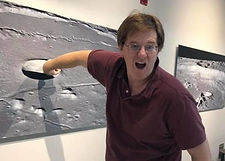10FM
Tune in to shift your perspective

10FM creates multimedia projects
that explore how human ideas form and change over time.
With our partners, we work toward a more inclusive, creative future.
From Chabot Space & Science Center's blog:
June 21, 2019
Camie Bontaites
CAPTIONING THE MOON
From the very beginning we knew we had a daunting task ahead of us. We wanted to tell you, our visitors, so much about the Moon – how lovely and ethereal it is, about its mythical and storied place in many cultures, its wild geographic history…and we couldn’t possibly leave out the astronauts, the lunar satellites and rovers… All this, written as concisely as possible.
We wrote and re-wrote every sign. We added words we loved, then took them out.
And then we did it again.
WORKING AND REWORKING
We re-worked the main exhibit sign at least 20 times, filled the margins with comments and suggestions about what should be included. We were so tempted to tell you, right when you walked in, that NASA’s Lunar Reconnaissance Orbiter (LRO), a satellite with an incredible set of scientific tools, was what brought you most of the images in the exhibit! We deleted it: it was too specific, too soon. You would have to wait …but what if you didn’t read the smaller sign that we ended up putting it on? You’d never know about the LRO! This would be tragic. (It would seem we stubbornly worked it into this post, though, just to be safe…)
If we’re following best practices while we’re writing and editing, we also gather input from other Chabot departments, visitors, and external “unbiased” editors. Many different ideas come into play. It is much like doing a puzzle, trying to fit the pieces/ideas in so that the big picture makes sense to whoever is looking at it. For Luminous Moon, we talked with scientists at NASA; researched how the Moon was being talked about in news articles, historic texts, and poetry; found out which questions kids asked most about the Moon; and drew on our Education Department staff’s expertise in working with students with many different learning styles.
THE EDIT-TEAM
While trying to wrangle all of these disparate ideas, and keep our own in check, we employed a vital tool – we laughed at ourselves, constantly. This would often happen after we had read a draft over and over, so many times that we could no longer truly see the words.
Our Astronomer and co-writer saved me from accidentally telling you all that craters were smashing into other craters on the Moon. (I had meant to say asteroids/meteorites were doing that.) Thanks to him, now you don’t have to stand before the sign, trying desperately to make sense of how craters could zoom around
like giant lunar bumper cars.
The long and short of it is: We conducted a rigorous and exciting exploration of everything we could find about the Moon. Along the way we discovered fascinating and surprising things. We feel like we see the Moon differently now.
We enjoyed the process thoroughly, and did our best to use just the right words to share all of this with you.
----------------
Camie Bontaites
FROM FANTASY TO REALITY: SCI-FI’S CONTRIBUTION TO SCIENCE
SCIENCE FICTION STORIES ARE IMAGINATION-INFUSED LABORATORIES, WHERE IT IS SAFE
TO EXPLORE WHAT APPEARS TO BE IMPOSSIBLE.
In some cases, these impossible ideas are tried and tested until they become possible, and we find ourselves in the “real world” laboratory of science. This happens more often than you might think, and with fantastic results.
1. THE FLIP PHONE
The flip phone was inspired by flip communicators
used by characters on Star Trek when they needed
to hail the Enterprise from the surface of a strange
new planet.
2. THE SUBMARINE
American inventor Simon Lake, whose designs helped
create early submarines, developed a lifelong interest
in undersea exploration after reading Twenty Thousand
Leagues Under the Sea. In this classic tale, Jules Verne
had imagined a great underwater ship – a submarine
powered by electricity and containing a grand ballroom
with a towering organ played by the maniacal Captain
Nemo. Sadly, newer versions don’t contain built-in
musical instruments, but the submarines have still
proven quite useful!
3. THE LIQUID FUELED ROCKET
After Robert H. Goddard read H.G. Wells’ classic The War of the Worlds, which he recalled, “gripped my imagination tremendously,” he went on to create the world’s first liquid fueled rocket in 1926, and his research became the foundation for all modern rocketry to follow.
AND MANY MORE!
There are many more examples: the hoverboard, tablets, robots, the defibrillator, the helicopter, the smart watch…
Imaginative stories provide powerful fuel for thinking beyond what we know. With a creative nudge from science fiction, science can live long, think wildly, and prosper.




That's my incredible team on the left. I missed the photo shoot on
"scaffolding day."













